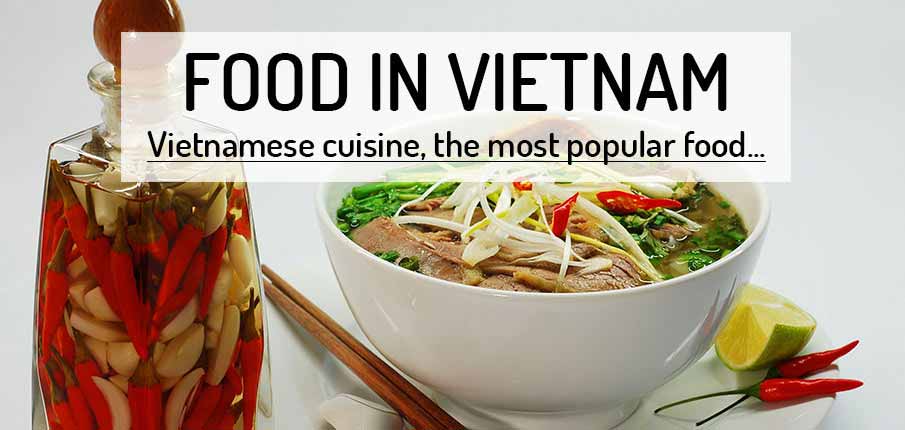

Vietnamese cuisine is one of the most popular cuisines of the world.
Vietnamese cuisine is made up largely of vegetables, fruits, herbs, rice and meat, and it is also very healthy. Traditional Vietnamese dishes are varied, distinct and are comparatively low in fat and high in carbohydrates. Now, even well-promoted. However, this must be done with reserve. Lots of fried, but very sweet foods, beverages and meals are not healthy enough.
Catering is an important group event of the day for the Vietnamese. Contrary to our style of eating, you have to get used to munching and burping, which are a sign of satisfaction with the food! Mess and litter around the tables and on the floor in street cafeterias is rife, you just have to put up with it.
Street food is standard – Hanoi is a paradise for the street food.
At almost every corner you will find a stall or a restaurant with soups, rice, a variety of meat or noodles. The street restaurants are often focused on only two or three meals, but the choice of restaurants is great and all their meals are different. This is especially so in Hanoi – it is a veritable paradise for street food. In the mountainous areas of northern Vietnam eating is a little more limited, and a little less variety but still not difficult to find.

The base ingredients of Vietnamese cuisine are rice and fish sauce.
Vietnam is the second-largest rice exporter in the world after Thailand. Rice is found growing throughout the country, from the fields in the lowlands to the mountain terraces. It is most bountiful in the Mekong Delta down south and you will see it when traveling in Vietnam. Rice appears at breakfast, lunch, dinner, and dessert. There’s rice-rice of course as well as rice noodles, rice paper wrappers, rice porridge, sticky rice with fruit, fried rice, puffed rice snacks, and rice wine.
Fresh vegetables, fruits, herbs and spices are commonplace.
In northern Vietnam, the cuisine varies a bit depending on where you are, whether in the mountains or in the city. In the city there’s a vast selection of food, you can taste almost everything here, while in the mountains it is largely represented by rice, fresh vegetables, herbs and meat. Meat is an expensive commodity for the people from ethnic minorities.
| Fruit Name | Viet. Name | Description |
|---|---|---|
| Jackfruit | Mit | This large fruit is a member of the fig family and can grow up to 100 pounds. It has a spiky exterior and a sweet, fleshy interior that’s often used as a meat substitute in vegetarian dishes. The flesh can be eaten raw or cooked and has a mild, sweet flavor. |
| Banana | Chuoi | Bananas are a staple fruit in Vietnam and are used in many desserts and snacks. They’re sweet and creamy, with a soft and slightly sticky texture. Bananas are also a good source of fiber, potassium, and vitamins C and B6. |
| Starfruit | Khe | This unique fruit has a star-shaped cross-section and a tangy, slightly sweet flavor. It’s often used in salads and drinks. Starfruit is a good source of vitamin C and fiber, and it’s also low in calories. |
| Custard apple | Mang cau | This fruit has a soft, creamy flesh that’s similar in texture to custard. It has a sweet, slightly floral flavor that’s highly prized in Vietnam. The fruit is typically eaten fresh and can be used in desserts or smoothies. |
| Rambutan | Chom chom | This small, spiky fruit has a soft and juicy flesh that’s similar in texture to lychee. It has a sweet and slightly tart flavor that’s highly addictive. Rambutan is often eaten fresh or used in desserts and jams. |
| Sapodilla | Lucuma | This fruit has a brown, rough exterior and a sweet, grainy flesh that’s similar in texture to a pear. It has a rich and complex flavor that’s highly prized in Vietnam. The fruit is typically eaten fresh or used in desserts and smoothies. |
| Guava | Oi | This fruit has a bright green skin and a sweet, slightly tart flesh that’s packed with vitamin C. It’s often used in drinks and desserts. Guava is also a good source of fiber and antioxidants, and it has been linked to a number of health benefits. |
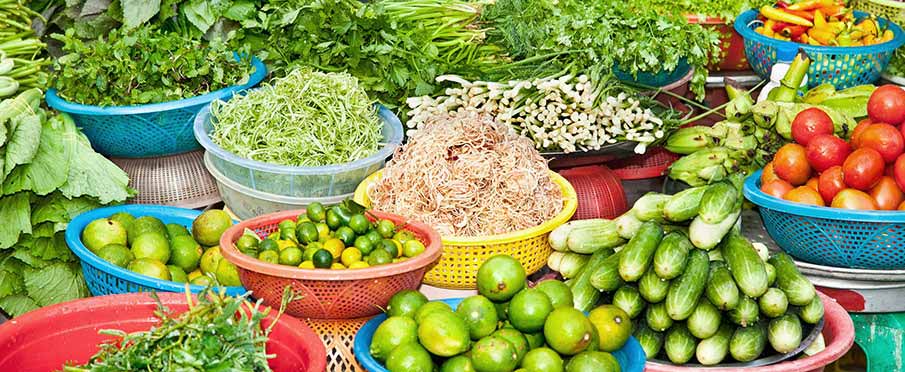
You can purchase excellent coffee, beer, hard liquor, juices or shakes in Vietnam.
Drinks in Vietnam are mainly, juices, tea (Tra Viet), mineral waters, and beers (Hanoi beer, Dai Viet, Bia Hanoi). There is also a good choice of fruit shakes (Sinh to). A specialty is the excellent and popular strong Vietnamese coffee (Ca Phe Sua). Coffee is often served with the sweet condensed milk at the base of a glass with ice cubes , and filter coffee poured on top, (If you order Cafe Fin you will get filter coffe in this style) . Vietnam is the world’s largest producer of Robusta coffee.
Taste a wide selection of fresh exotic fruit drinks.
In mountainous areas rice wine (Ruop Nep cam) is also very popular as the main beverage. In shopping centers in the larger cities it is easy to find strong alcohol. If you want more information about the beers sold in Vietnam, you can visit the website Beervn.
| Beverage Name | Description |
|---|---|
| Vietnamese iced coffee | This strong and sweet coffee is made with condensed milk and served over ice. It’s a perfect pick-me-up on a hot day. |
| Sugarcane juice | Made from fresh sugarcane, this juice is sweet, refreshing, and often served with a wedge of lime. |
| Coconut water | This clear liquid is extracted from young green coconuts and is a deliciously refreshing way to stay hydrated on a hot day. |
| Green tea | Vietnamese green tea is often served alongside meals or as a digestive aid after eating. It’s light and fragrant, with a slightly sweet taste. |
| Lotus tea | This fragrant tea is made by placing lotus flowers in green tea leaves and allowing the tea to absorb the floral aroma. It’s often served at formal events and is considered a symbol of purity and beauty. |
| Soy milk | A popular non-dairy alternative to milk, soy milk is often served hot or cold and sweetened with sugar or condensed milk. |
| Fresh fruit juice | Made from a variety of fruits, such as mango, watermelon, and pineapple, these juices are refreshing and full of vitamins. |
| Bia hơi | A type of light and refreshing draft beer that’s popular in Vietnam, especially in the northern regions. |

The most famous dishes of Vietnamese cuisine:
• a variety of chicken and beef soup (Pho Bo, Pho Ga, Bun Bo Hue)
• rice (Com), noodles (Bun) – in several ways, all with rich Annex vegetables
• rolls, rolls (banh cuon, Goi cuon, Nem cuon, plagues DEU) vegetables or other attachment.
• meat Dishes – Bun Cha (grilled meat with noodles and vegetables), Bo kho (braised beef with vegetables and noodles)
• Banh Mi Vietnamese sandwiches, in mountainous areas, however, I have seen
• Banh Chung sticky rice cake and Banh Beo steamed rice cakes
• Goi Vietnamese salad (beef, chicken, vegetarian, shrimp…)
• Bahn Xeo pancakes
• seafood and incomprehensible to us – snakes, frogs, dog meat
| Dish | Description |
|---|---|
| Pho | A noodle soup with a rich, flavorful broth and various meats and herbs. |
| Banh Mi | A sandwich with a crispy baguette filled with a variety of meats, vegetables, and sauces. |
| Goi Cuon | Fresh spring rolls with shrimp, pork, vegetables, and herbs wrapped in rice paper. |
| Bun Cha | Grilled pork served with vermicelli noodles, herbs, and a dipping sauce. |
| Com Tam | Broken rice served with various toppings such as grilled pork, fried egg, and pickled vegetables. |
| Bo Kho | A spicy beef stew served with bread or noodles. |
| Bun Bo Hue | A spicy beef noodle soup originating from the city of Hue. |
| Cha Gio | Crispy fried spring rolls filled with pork, shrimp, and vegetables. |
| Ca Kho To | Caramelized fish in clay pot, usually served with rice. |
| Canh Chua | A sour soup made with fish, vegetables, and tamarind broth. |
| Xoi | Sticky rice served with various toppings such as grilled pork, chicken, or fried egg. |
| Banh Xeo | A savory crepe filled with pork, shrimp, bean sprouts, and herbs. |
| Ca Phe Trung | A coffee made with egg yolk, condensed milk, and coffee. |
| Mi Quang | A noodle dish from Quang Nam province, made with turmeric noodles, pork, shrimp, and herbs. |
| Banh Cuon | Steamed rice rolls filled with minced pork, mushrooms, and onions. |

The staple favorite Vietnamese food – PHO soup:
• soups – eaten for breakfast, but also for lunch and dinner
• favorite street food of Vietnamese cuisine
• special and specific taste and flavor
• ingredients and spices can differ from place to place (chilli sauce, onion, cilantro, herbs, lime, pepper …)
• Banh Mi is Vietnamese sandwich
• rice noodles are an important ingredient made from Gao Te fragrant rice
• beef Pho Bo, chicken Pho Ga, stir-fried noodles Pho Xao
| Pho Variation | Description | Location |
|---|---|---|
| Pho Bo | The traditional pho made with beef broth and slices of beef. | Throughout Vietnam |
| Pho Ga | Pho made with chicken broth and slices of chicken. | Throughout Vietnam |
| Pho Chay | A vegetarian version of pho, made with vegetable broth and tofu or other meat substitutes. | Throughout Vietnam |
| Pho Tai | Pho made with rare beef slices that cook in the hot broth. | Throughout Vietnam |
| Pho Chin | Pho made with well-done beef brisket. | Throughout Vietnam |
| Pho Nam | Pho made with beef flank. | Throughout Vietnam |
| Pho Sot Vang | Pho served with a tomato-based broth and beef slices. | Throughout Vietnam |

Vietnamese food at the festivities of ethnic people in the villages.
Vietnamese food and catering in villages or in the mountains is an important part of the traditional celebrations and festivities. Various ceremonies and rituals can be seen mainly in mountainous areas with ethnic people. Weddings, funerals, the Tet feast or the birth of a child is accompanied by a large feast in the community. The intervention of the Vietnamese government has eliminated some spiritual celebrations of ethnic populations in the mountains.
The food of ethnic residents in the mountains is different from urban areas
The most popular food at these celebrations has become mainly pork, chicken and vegetable dishes served with rice. As a complement to these foods alcohol is served – rice wine. Meals are usually eaten with chopsticks. Festivities are socially important because they provide a context in which people maintaingood social cohesion. The situation is similar in urban areas, meals, however, are richer and can be supplemented with traditional liquor and alcohol.
| Ethnic Group | Region | Popular Dishes |
|---|---|---|
| Kinh (Vietnamese) | Vietnam | Pho (noodle soup), banh mi (baguette sandwich), bun cha (grilled pork with vermicelli noodles), com tam (broken rice with grilled pork) |
| H’mong | Highlands | Thang co (soup made with horse meat and organs), xoi ngo (sticky rice with corn), smoked pork |
| Tay | Northern region of Vietnam | Thang den (black bean soup), lau (hot pot), xoi gac (sticky rice with gac fruit) |
| Khmer | Southern region of Vietnam | Amok (curry made with fish or meat), num banh chok (rice noodles served with fish curry), bai sach chrouk (grilled pork with rice) |
| Chinese Vietnamese | Vietnam | Banh bao (steamed bun), banh cuon (steamed rice rolls), banh gio (sticky rice dumplings) |
| Cham | Central Vietnam | Banh duc (rice cake), mi quang (turmeric noodles with shrimp and pork), chao (rice porridge) |

Food on the streets of Hanoi (Hanoi street food).
When moving around in Hanoi you will see the constant presence of street vendors with food. Hanoi is a popular place for street food and the locals eat on the street everyday and all day . Most of the locals eat out with hundreds of small tables and chairs set up mostly in the evening. Hundreds of mini-restaurants, stalls, small mobile shops on wheels, women with hanging baskets of fruit, varied, tasty and healthy meals, you’ll see it all in Hanoi!
You can also go on a „Street food tour“ in Hanoi.
This way of eating is also for many people their only source of livelihood. Prices for food purchased on the street are very low, but at the historic sites they may be a little bit higher. The best place to try local cuisine in Hanoi is the Old Quarter. The most common dishes that you can try are Pho soup, rice in several ways (Com Tam, Xoi), Bahn Mi sandwiches, rice noodles (Bun), Rolls (Banh Cuon), salads (Goi) and other dishes. If you want to learn more about vietnamese cuisine and try very unusual dishes then try a “Street food tour“.
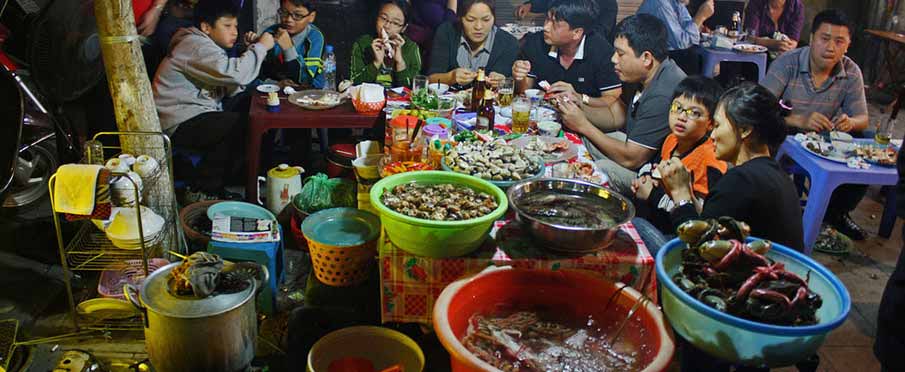
Restaurants with European dishes can only be found in tourist places.
Restaurants with European cuisine do exist, but, I can say that the quality of food isn‘t up to European standards, and meals are overpriced. These foods from Europe and America do not fit in anywhere with Vietnamese cuisine. In Vietnam you can also find dog meat and various cattle offal and larvae and snails. During my traveling i have seen these foods every now and again.
I fully recommend eating in the street restaurants, it’s very cheap and often very tasty, but be careful about hygiene. Real Vietnamese cuisine is only found on the street.

Exotic fruit in Vietnam is very widespread and very tasty.
Vietnam lies in the tropics and therefore you can taste lots of interesting exotic fruit. The best conditions and places for fruit cultivation is in southern Vietnam. However, even in the north, of course, you can buy exotic fruits. In northern Vietnam there is also cultivation of apples, strawberries, grapes, peaches, pears and plums as well (a bit different than we are familiar with). Juices, jams and other desserts are also produced from the exotic fruit.
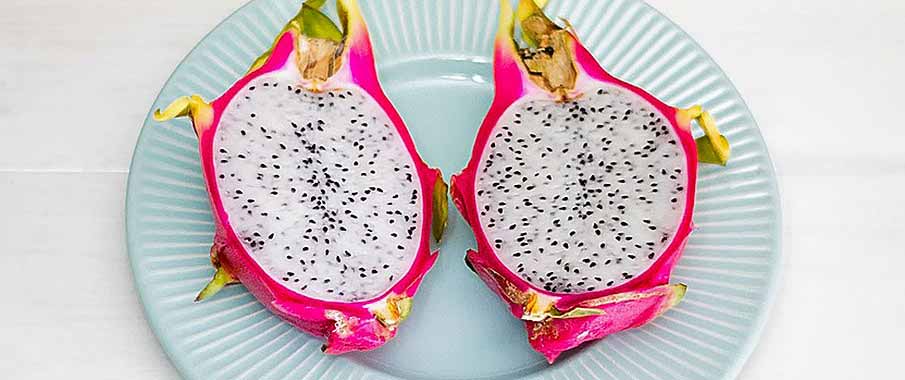
The fruit is also used as an ingredient in food and fruit desserts.
The most abundant fruit in Vietnam is bananas, tangerines, grapefruits, mangoes, limes, lemons, rambutan, pineapple, mangosteen, papaya, jackruit, pitahaya (dragon fruit), lychee, durian, star apple … Tropical Fruit provides a number of vitamins (A + C) and it is rich in carbohydrates, minerals and fiber. The fruit is certainly healthy, in cities it may be a little contaminated. It is better to buy fruit out of town and not on the main busy street.

Other popular dishes of Vietnamese cuisine:
> Bun bo Hue (Bún bò Huế)
– well-known food mainly in Hue (central Vietnam)
– soup contains rice noodles (Bun) and beef (Bo)
– spicy, sour, salty, sweet taste, aroma of lemon grass
> Banh canh (Bánh canh)
– broth with strong noodles, can be made from tapioca flour or mixtures of rice
– various kinds – with crab, pork, shrimp, fish

> Banh xeo (Bánh xèo)
– crispy pancake made from rice flour with shrimp, pork, bean sprouts, herbs
– Ban xeo is dipped into special sauce
– in southern Vietnam with coconut milk
> Banh cuon (Bánh cuốn)
– Banh cuon is made from a thin, wide sheet of steamed fermented rice
– filled with boiled pork, mushrooms, onion
– „cha lua“ pork sauce, cucumber, bean sprouts

> Nem ran (Nem rán)
– crispy spring rolls filled with vegetables, meat
– herbs, vegetables, lime, dipped in spicy sauce
> Bun rieu (Bún riêu)
– soup with rice noodles and meat, there are several types of this dish
– served with tomato, crab broth, supplemented with shrimp paste
– supplemented by also tamarind paste, fried tofu, mint, bean sprouts

| Advantages of Vietnamese cuisine: | Disadvantages of Vietnamese cuisine: |
|---|---|
| Health benefits: Vietnamese cuisine is generally considered to be a healthy cuisine due to the use of fresh, nutrient-rich ingredients such as herbs, vegetables, and fruits. Additionally, Vietnamese cuisine is low in fat and calories, which makes it a good choice for people who are watching their weight. | High sodium content: One of the downsides of Vietnamese cuisine is that it can be high in sodium, especially in dishes that use fish sauce or soy sauce as a flavoring agent. This can be a concern for people who are watching their sodium intake, as too much sodium can lead to high blood pressure and other health problems. |
| Delicious flavors: Vietnamese cuisine is known for its unique and delicious blend of flavors, which is achieved through the use of a variety of herbs, spices, and sauces. Some of the most common flavorings used in Vietnamese cuisine include fish sauce, soy sauce, lemongrass, and chili peppers. | Heavy use of carbohydrates: Vietnamese cuisine is heavily reliant on carbohydrates such as rice, noodles, and bread, which can lead to high carbohydrate intake. This can be a concern for people who are trying to watch their carbohydrate intake, as too many carbohydrates can lead to weight gain and other health problems. |
| Variety: Vietnamese cuisine offers a wide range of dishes to choose from, including soups, noodle dishes, rice dishes, and grilled meats. This makes it easy for people to find something they like, no matter what their tastes are. | Limited use of dairy: Vietnamese cuisine does not use much dairy, which can be a downside for people who enjoy dairy-based dishes. However, this can also be a benefit for people who are lactose intolerant or have other dairy-related health concerns. |
| Vegetarian-friendly: Vietnamese cuisine offers a variety of vegetarian options, including dishes made with tofu, vegetables, and noodles. This makes it a great choice for people who are vegetarian or vegan. | Time-consuming preparation: Some Vietnamese dishes can be quite complex and time-consuming to prepare, with many steps and ingredients. This can be a challenge for people who are short on time or who are not experienced in the kitchen. However, there are also many simpler Vietnamese dishes that are quick and easy to prepare. |
Foody – guide to restaurants and cafes in Vietnam:
You arrive in Vietnam, for example you are going to Hanoi or Ho Chi Minh City. You want to go out for dinner, lunch or coffee. But how to make sense of those hundreds and thousands of restaurants that you will see in the streets. But where to find quality restaurants and cafes in Vietnam? How’s the food looks and how much it costs? Maybe it will help a great vietnamese mobile application – Foody (available also in English). This application will show you almost all restaurants, cafes and bistros on the map. And not only that. But shops and some tourist attractions but also some places for recreation. Preliminarily, you can also look on the web Foody.vn.
– application is for Android, iOS and Windows Phone
– localized to English (the names of dishes and promotions are in Vietnamese)
– allows the delivery to the address (depending on the price of the order), or restaurant reservations
– in the selection are other restaurants with a specific cuisine (European, Korean, Italian …)
– restaurant reviews, visitors and thousands of photos of dishes bistros, cafes … growing daily
– more information about Foody
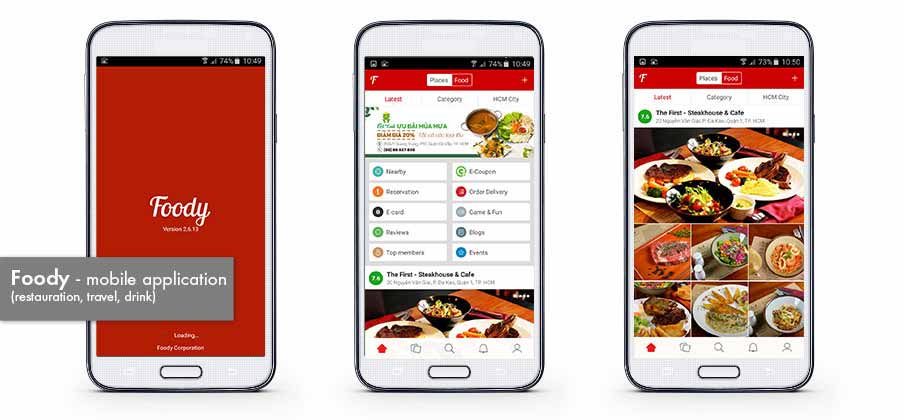
A few recommendations in Vietnam:
> Wash purchased fruits, vegetables and herbs and buy only bottled water!
> When you have indigestion, try using probiotics!
> It is not recommended to drink tap water!
> Do not eat smelly food!
>> 30 best Vietnamese restaurants and bistros in Prague + Map <<
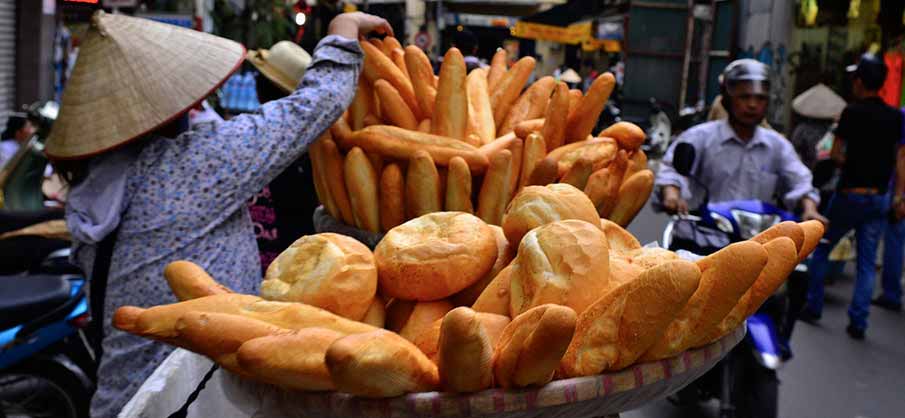
❓ Frequently Asked Questions about Vietnamese Cuisine:
1. What is Vietnamese cuisine known for?
-
- Vietnamese cuisine is known for its fresh and vibrant flavors, diverse ingredients, and a balance of sweet, sour, salty, and spicy tastes. It features an abundance of herbs, vegetables, rice, noodles, and seafood, making it a delightful culinary experience.
2. What are some popular Vietnamese dishes?
-
- Some popular Vietnamese dishes include phở (rice noodle soup with beef or chicken), bánh mì (Vietnamese sandwich), gỏi cuốn (fresh spring rolls), bún chả (grilled pork with noodles), bánh xèo (Vietnamese savory pancake), and cà phê đá (Vietnamese iced coffee).
3. What are the key ingredients used in Vietnamese cuisine?
-
- Key ingredients used in Vietnamese cuisine include fish sauce, shrimp paste, lemongrass, lime, chili, garlic, ginger, fresh herbs like mint and cilantro, rice, noodles, and a variety of vegetables and fruits.
4. Is Vietnamese cuisine spicy?
-
- Vietnamese cuisine can be spicy, but not excessively so. It typically relies on the balance of flavors rather than overwhelming spiciness. Chili is often used as a condiment, allowing diners to adjust the level of spiciness according to their preferences.
5. Are vegetarian options available in Vietnamese cuisine?
-
- Yes, Vietnamese cuisine offers a wide range of vegetarian options. Dishes like bánh xèo (vegetarian savory pancake), gỏi cuốn (vegetable spring rolls), phở chay (vegetarian rice noodle soup), and cơm chay (vegetarian rice dish) are popular choices for vegetarians.
6. What is the typical breakfast in Vietnam?
-
- A typical Vietnamese breakfast often includes dishes like phở, bánh mì, xôi (sticky rice), or bún riêu cua (crab noodle soup). Vietnamese people also enjoy a cup of cà phê đen (black coffee) or trà (tea) with their breakfast.
7. What are some popular street foods in Vietnam?
-
- Some popular street foods in Vietnam include bánh mì (Vietnamese sandwich), bánh cuốn (steamed rice rolls), bánh tráng trộn (rice paper salad), bánh mì xíu mại (meatball sandwich), and chè (sweet dessert soup).
8. Is it safe to eat street food in Vietnam?
-
- Yes, street food in Vietnam is generally safe to eat. However, it is advisable to choose stalls with a high turnover of customers, as it ensures the freshness of the food. Also, make sure the food is thoroughly cooked and served hot.
9. What is the role of herbs in Vietnamese cuisine?
-
- Herbs play a significant role in Vietnamese cuisine, adding freshness, aroma, and flavor to the dishes. Common herbs used include Vietnamese mint, Thai basil, cilantro, sawtooth herb, and perilla leaves. They are often used as garnishes or added to soups, salads, and rice paper rolls.
10. Are there regional variations in Vietnamese cuisine?
-
- Yes, Vietnamese cuisine exhibits regional variations due to the country’s diverse geography. For example, in northern Vietnam, you’ll find dishes like bún chả and phở, while in the south, bánh xèo and bánh mì dominate. Each region has its own specialty dishes and flavors influenced by local ingredients and traditions.
BOOK A TOUR / ACTIVITY in Vietnam ➜
